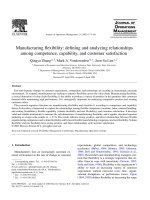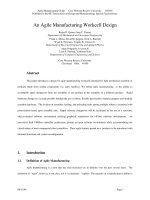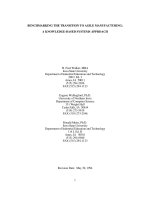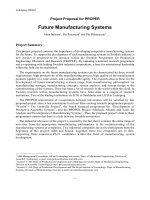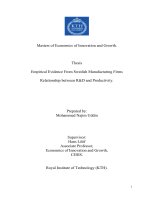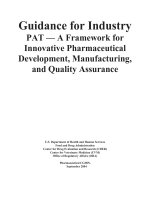fabric manufacturing technology-1
Bạn đang xem bản rút gọn của tài liệu. Xem và tải ngay bản đầy đủ của tài liệu tại đây (1.88 MB, 64 trang )
TEXTILE
A Textile was originally a woven fabric but now the term textile and its
plural textiles are also applied to fibers, filaments, yarn and most
products for which these are a principle raw material. The product
includes threads, cords, ropes, braids woven, knitted, non-woven fabrics,
nets, household textile, geo-textile, medical textiles etc.
WEAVING
Weaving is the action of producing fabric by the interlacing of warp and
weft thread. The warp threads are placed along the length of the fabric
and the weft threads are placed along the width of the fabric.
Example of Different Textile-
Geo-Textile: Embankment
Medical Textile: Non-alginate fabric, Bandage tape etc.
Non-woven Fabric: Tea bag, Tissue paper.
House Hold Textile: Curtain, Cover of soffa set.
Southeast University – Department of Textile Engineering
1
FLOW CHART OF WEAVING
Yarn
(In the form of spinner’s package)
Warp Preparation Weft Preparation
Winding (cone, cheese) Winding (Cop, Pirn,
Cone, Cheese)
Warping (Pre beam/ Warper’s
beam/ back beam) Weaving (Fabric)
Sizing (weaver’s beam)
Drafting, Drawing, Pinning
Denting, Looming
Weaving (Fabric)
Three types of yarn package are mention bellow
Cone Flange bobbin Cheese
Southeast University – Department of Textile Engineering
2
1. Woven fabric (Shirt)
2. Knitted fabric (T-shirt)
3. Non-woven fabric (Tea pack)
4. Special fabric (Fire proof fabric, water proof fabric)
OBJECTS OF YARN PREPARATION
Yarn preparation is important to facilitate the next processes of weaving.
The objects of yarn preparation are mentioned bellow:
To remove yarn faults ( there are 23 types of yarn faults)
To transfer the yarn from spinner’s package to a convenient form of
package which will facilitate weaving.
To have desired length of yarn on a package.
To clean the yarn for better appearance and performance.
To make good quality fabric.
To reduce labour cost.
FAULTS TO BE REMOVED DURING YARN-PREPARATION
1. Thick place
2. Thin place
3. Slubs Place
4. Loose fibers
5. Count variation
6. Foreign particles (seed, leaf, dust, bollworm, honeydew)
7. Neps
Southeast University – Department of Textile Engineering
3
Intentional
Unintentional
TYPES OF
QUALITY OF GOOD WARP
The essential features of good warp is mentioned bellow-
The yarn must be uniform, clean and free from knots as much as
possible.
The yarn must be sufficiently strong with withstand the stress and
friction without end breakage.
Knots should be a standard size and type. So that they can pass the
heald eye, dropper, read easily.
The warp must be uniformly sized and size coating should be thick
enough to protect the yarn various function.
The ends of warp must be parallel and each must be wound onto a
weaver’s beam at an even and equal tension.
All warp yarn should of same size in length.
Southeast University – Department of Textile Engineering
4
TYPES OF PACKAGE
Cone (for warp yarn)
Cheese (for warp yarn)
Spool (for silk, jute warp yarn)
Flanged bobbin (for warp yarn)
Cop (for jute weft)
Pirn (for cotton weft)
Spinner package
TYPES OF PACKAGE WINDING
There are three types of package winding available.
1. Parallel wound package
2. Near parallel wound package
3. Cross wound package
1. Parallel Wound Package Features
a) Many yarn can be wound at a time.
b) No need of traversing motion.
c) Side withdrawal is possible.
d) The density of yarn is more.
e) No change of twist/inch.
f) For yarn unwinding separate mechanism is needed.
g) Two side of the package needed flanged.
2. Near Parallel Wound Package Features
a) No need flange here.
b) Both side and overend withdrawal is possible.
c) Twist/inch can be changed.
d) Traversing motion is needed.
3. Cross-Wound Package Features
Southeast University – Department of Textile Engineering
5
PACKAGE
a) Here no flange is required.
b) Traversing mechanism is must.
c) Twist/inch changes.
d) Only overend withdrawal is possible.
e) Yarn ballooning occurs during unwinding.
f) This package is very stable.
Southeast University – Department of Textile Engineering
6
PACKAGE
TYPES OF PACKAGE DRIVING
There are three types of package driving system.
A. surface contact driving (indirect system)
B. direct driving at constant angular speed
C. Direct Driving At Variable Angular Speed
A. SURFACE CONTACT DRIVING (INDIRECT SYSTEM)
In this system, the yarn package is placed with a surface contact of a
drum. The drum is driven by a motor and some gear. When it rotates the
package also rotate is reverse direction.
B. DIRECT DRIVING AT CONSTANT ANGULAR SPEED
In this system, the package is placed on a spindle. The spindle is driven
by a motor and some gears. So the package gets a constant angular
speed. Here yarn take up rate is directly proportional to the package dia.
C. DIRECT DRIVING AT VARIABLE ANGULAR SPEED
Southeast University – Department of Textile Engineering
7
In this system, yarn package is directly driven at a variable angular speed
to give a constant yarn speed. Here the package speed is inversely
proportional to the package radius,
I.e. Package speed
Southeast University – Department of Textile Engineering
8
1
Package radius
BALLOONIN
The appearance of the curved path of running yarn during unwinding or
overend withdrawl from package under appropriate winding condition
through a guide, placed above and in line with the axis of the package at
an adequate distance from it, the yarn assumes the appearance of a
balloon shape. This circumstance of assuming balloon shape of yarn is
called ballooning.
FACTORS EFFECTING THE SHAPE AND SIZE OF BALLOON
Package size Ballooning
Yarn guide distance Ballooning
Lift the package Ballooning
Count of yarn Ballooning
Air resistance Ballooning
Unwinding rate. Ballooning
Southeast University – Department of Textile Engineering
9
YARN WITHDRAWAL OR
The unwinding process of yarn from package is called yarn withdrawal.
There are two types of yarn withdrawal system:
1. Side Withdrawal
2. Overend Withdrawal
1) Side Withdrawal
The features of side withdrawl of yarn are given bellow;
a) Package will rotate in side withdrawal.
b) Yarn twist will be unchanged.
c) No formation of balloon occurs.
d) It is applied to flanged bobbin.
e) The rate and speed of unwinding is slow.
2) Overend Withdrawal
The features of overend withdrawl are given bellow;
a) Package remains stationary during unwinding.
b) Formation of balloon occurs.
c) Twist/inch of yarn changed.
d) Generally cop, pirn, cone, chess are packages used for overend
withdrawl.
e) The rate of unwinding is high.
Southeast University – Department of Textile Engineering
10
YARN
In winding and unwinding some small component control yarn path which
is very necessary, yarn guide is used to perform this job.
TYPES OF YARN GUIDE
There are two types of yarn guide
a) Yarn Guide For The Yarn Whose Ends Are Required For
Threading;
For this type of yarn guide extra time is needed for threading. So speed of
operation is decreased. The yarn which passes through this guide faces
more friction.
Like Ceramic, Tumpet, Bust
b) Yarn Guide For The Yarn Whose Ends Are Not Required For
Threading;
Here threading is very easy. So the speed of the operation is high. Yarn
passes through this guide faces less friction.
Southeast University – Department of Textile Engineering
11
Figure: Yarn Guide
TENSION
During winding, we have to impart proper tension to yarn, so that we can
get a stable and undamaged package. So we pass the yarn through a
device called tension device.
Types of Tension Device
There are four types of tension device as follow;
a) Capstan Tensioner.
b) Additive Tensioner.
c) Combined Tensioner.
d) Automatic Tensioner.
A. CAPSTAN TENSIONER
It is the simplest type of yarn tensioner. It works only by deflecting the
yarn around fixed posts. This includes a capstan effect on yarn. It works
by the following formula:
Output Tension = Input Tension × e
μθ
or, T
2
= T
1
e
μθ
Where,
T
2
= Output tension.
T
1
= Input tension.
e = Constant tension = 2.78
μ = Co-efficient of friction.
θ = θ
1
+θ
2
+θ
3
= Angle of lap.
B. ADDITIVE TENSIONER
Southeast University – Department of Textile Engineering
12
This is also a simple technique of applying tension on yarn. In this device
a dead weight or spring is used in the middle of the two surfaces in
contact and the force is applied to give suitable tension to the yarn.
Hence the output tension is expressed by,
T
2
= T
1
+ 2μF
Where,
T
1
= Input tension.
T
2
= Output tension.
µ = Co-efficient of friction.
F = Applied force.
C. COMBINED TENSIONER
It is the combined form of additive and capstan tensioner. The device
permits the tension level to be raised to any desired level, but doesn’t
permit a reduction of tension. Here output tension is expressed as follow:
T
2
= T
1
+ 2μF + T
1
e
μθ
Where,
T
1
= Input tension.
T
2
= Output tension.
µ = Co-efficient of friction.
F = Applied force.
θ = Angle of lap.
D. AUTOMATIC TENSIONER
Southeast University – Department of Textile Engineering
13
It is a simple tensioner in which yarn tension is controlled automatically.
It has a lever with spring loaded disc in one side and applied load in
another side. The device is designed in such a way that if applied tension
is too high. The pressure on disc is reduced to bring the tension back to
its proper level.
Southeast University – Department of Textile Engineering
14
EFFECT OF TENSIONING
There are some effects of tension to the yarn or package: They are
a) If tension is too high.
b) If tension is too low.
c) If tension varies.
a) If Tension is Too High
Hard package.
Breakage rate increases.
Elongation of yarn
Shade variation.
Weak the thin place.
c) If Tension Varies
Problem during unwinding.
Package unstable.
Irregularity among yarn.
Auxiliary Function in Winding
Creeling.
Piecing.
Doffing.
CHOICE OF TENSIONING DEVICE
It must be reliable.
It must be easily threaded.
It must neither introduce nor magnify tension variation.
It must not change the twist of yarn.
It must not be affected by wear.
It must be easily adjustable.
It must not be affected by the presence of oil and dirt.
It must not encourage the collection of dirt and lint.
It must be easy cleaning.
The operating surface must be smooth.
It must be cheap.
It must not cause any type of damage to yarn i.e. shade variation,
elongation yarn breakage.
PRECISION WINDING FEATURES
Packages are wound with reciprocating traverse.
Package contains more yarn.
Southeast University – Department of Textile Engineering
15
b) If Tension is Too Low
Loose package.
Unstable package.
Slough off.
WINDIN
Low stability of package.
Hard and more compact package.
Low unwinding rate.
The wound coils are arranged parallely or near parallely.
FEATURES OF NON-PRECESSION WINDING
Coils are cross wound.
Package is of low density.
Less amount of yarn is stored in package.
High stability of package can be obtained.
Flange is not necessary.
Unwinding rate is very high.
Difference between Precession and Non-Precession Winding
Precession winding Non-Precession winding
1. The wound coil arranged parallel
or near parallel.
1. The coil is cross wise wound.
2. The yarn density of the package
is high.
2. The yarn density of a package is
low.
3. Flanged bobbin may be used. 3. Not use of flanged.
4. The yarn package is hard and
more compact.
4. The yarn package is soft and less
compact.
5. Low stability of the package. 5. High stability of the package.
6. Winding angle is 90° or near 90° 6. Winding angle is less than 80°
7. The bobbin is wound with one or
more threads
7. The bobbin is wound with single
thread.
8. Yarn tension is comparatively
high.
8. Yarn tension is comparatively low
9. Unwinding rate is low. 9. Unwinding rate is high.
MATH-1
Calculate the time required to wind 500 lbs of 24 Ne cotton yarn on 15
drums, where the actual production per drum per minute is 560 yds.
Given
Production= 560yd/min/drum, 24 Ne, yarn= 500lb, time=?
Southeast University – Department of Textile Engineering
16
Solution
24 Ne means,
1 lb. of yarn contains = 24X840 yds. yarn
500 lbs. of yarn contains = (24X840X500) yds. yarn
560 yds. of yarn to wind in 1 drum needs =1 min
1 yd. “ “ “ 15 drum “ =1/ (560X15) min.
(24X840X500) yd “ “ 15 drum = (24X840X500) / (560X15) min.
=1200 min.
=20 hr.(ans.)
Math-2
Calculate the drum required to wind 900 lbs of 25 Ne cotton during the
time 28 hrs, where the actual production per drum per minute is 600
yds
Given,
Production=600yd/min/drum
25 Ne, Yarn=900 lbs, time=28 hr., Find number of drum.
Solution
25 Ne of yarns means,
1 lb of yarn contains = 25X840 yd yarns.
500 lb of yarn contains =(25X840X900) yd yarns.
600 yds. of yarn to wind in 1 min in = 1 drum
1 yd ’’ ’’ ’’ (60X28) min in = 1 / (600X60X28) drum.
(25X840X900) yds. ’’ (60X28) min = (25X840X900) / (600X28X600)
drum
= 18.75 drum
= 19 drum (ans.)
Winding is a part of total number of ends of a warp in full width on to a
back beam from cone or cheese is known as warping.
Southeast University – Department of Textile Engineering
17
WARPIN
OBJECTS OF WARPING
To prepare a beam to make a fabric.
To increase the wave ability of fabric.
To make a convenient yarn sheet for sizing.
To wound up required length of yarn onto a warp beam.
To facilate the weaving of complex color pattern.
To make reusable small packages
REQUIREMENT OF WARPING
During warping the following requirements should be fulfilled.
1. The tension of all wound end must be uniform and possibly constant
throughout the withdrwal process.
2. Warping should not impair the physical and mechanical properties of
yarn.
3. The surface of warping package must be cylindrical.
4. A pre-determined length of yarn should be wound on beam from every
package.
5. The production rate of warping should be as high as possible.
6. If possible, yarn faults should be removed.
TYPES OF WARPING
Mainly there are two types of warping,
a) Direct/ high speed warping
b) Sectional warping.
Some Other Special Types of Warping Are Available
a) Ball warping
b) Chain warping
c) Cross warping
A. SECTIONAL WARPING
Sectional warping is a process of preparing warp beam over two stages.
In first stage yarns are wound in narrow tapes on a large drum. Then in
the second stage the rewinding of the warp onto a beam is performed.
This process is slow but suitable for complex color pattern.
Southeast University – Department of Textile Engineering
18
B. DIRECT/HIGH SPEED WARPING
High speed warping is a process of preparing warp beam directly from
yarn package. Here all the yarns are wound on a simple flange beam at a
time. This process is suitable for single color pattern.
FEATURES OF SECTIONAL WARPING
Sectional warping is suitable for producing color fabrics with different
pattern.
Production is less in sectional warping. So it is a costly process.
In sectional warping, tension cannot be kept uniform.
Here tapered drum is used as drum.
Hand weaving is necessary to produce sample fabric for bulk
production.
FEATURES OF HIGH SPEED WARPING
High speed warping is suitable for producing fabric with same count
and same color yarn.
Higher amount of yarn is required here.
The speed and production of a high speed warping is very high.
Here simple flanged bobbin is used as beam.
Difference between Sectional Warping and High Speed Warping
High Speed Warping Sectional Warping
1. Used to produce common fabric. 1. Used to produce fancy fabrics.
2. Production is high. 2. Production is low.
Southeast University – Department of Textile Engineering
19
3. Large amount of yarn is required. 3. Small amount of yarn is required.
4. Weavers beam is produced after
sizing.
4. Weavers beam is directly
produced.
5. Cone and Cheese is used. 5. Flanged bobbin or drum is used.
6. The process is cheap. 6. The process is expensive.
7. High creel capacity. 7. Low creel capacity.
8. Most commonly use. 8. Rarely used.
Control System in Warping
Tension control
Balloon control
Stop motion
Yarn cleaner
Length control
Surface speed control
Proper yarn density
Static electricity
Traverse control
Fly control
Description of Different Control Systems in Warping
1. Tension Control: Tension should not be low or high during warping.
Because due to lower tension package will be unstable, entangled and
snarling will occur. Whereas high tension will cause yarn breakage. The
tension should be just and uniform throughout the process.
Southeast University – Department of Textile Engineering
20
Faults in Warping
Off center warp
Reged or uneven warp
Cross end
Snarl formation
Hard/soft beam
End missing
Haphazard knotting
Length variation
2. Balloon Control: Balloon controlling is necessary so that the yarns
does not entangled with one another. For this, yarn guides should be
placed at right positions.
3. Stop Motion: The m/c should stop itself if any yarn breakage occurs
at any point. So stop motion system is necessary to control.
4. Yarn Cleaner: Proper setting should be maintained to remove yarn
faults.
5. Length Control: the Length of warp sheet should be controlled. It is
done with a measuring roller in combination with a suitable counting
device by stopping the device machine after winding pre-determined
length of warp yarn onto the beam.
6. Surface Speed: The surface speed of beam should be controlled
specially when a large change in warp diameter is involved.
7. Proper Yarn Density: In warp sheet the yarn ends/inch, means yarn
density, is to be controlled. Because without proper yarn density the
fabric will be uneven.
8. Static Electricity: It is specially required in case of man-made fibres.
It is controlled to avoid yarn entanglement. It is done by:
i. Chemical fiber finishes
ii. Ionization of air.
iii. Humidification of air.
9. Traverse Control: In sectional warping traverse rate of beam should
be controlled.
10. Fly Control: In staple fibres lints, small trashes may cause problem
by flying around the working area. So this fly should be controlled to have
a pleasant working atmosphere.
Description of Different Faults in Warping and Their Remedies:
1. Off Centre Warp: If beam or wraith is not set properly i.e. it is not
centric due to carelessness this type of fault occurs.
Remedy: Beam or wraith should be placed proper
2. Rigid or Uneven Warp Surface: This may occur if
Southeast University – Department of Textile Engineering
21
i. Yarn density [ends/inch] is very low.
ii. Different counts of yarns is wound on beam/
iii. Yarn density is uneven.
Remedy: yarn density and count should be maintained properly.
3. Cross Ends: If occurs due to faulty knotting after end breakage.
(Joining broken end with wrong end)
Remedy: Knotting and tension should be done carefully.
4. Snarl Formation: Snarl form due to over tension, highly twisted yarn
and careless operation.
Remedy: Tension should be kept proper and yarn twist should be as
required.
5. Hard/Soft Beam: If during winding yarn on being yarn tension is low
or high soft and hard beam forms. It may also occur due to uneven
pressure on drum or beam.
Remedy: Tension and pressure should be maintained even.
6. End Missing: If yarn breakage occurs m/c should be stopped
immediately. If such cannot be done the broken end of yarn cannot be
found out. This is end missing problem.
Remedy: Stop motion system should be very active and m/c should be
stopped immediately after end breakage.
7. Haphazard Knotting: if various length of yarn is wound in creel
packages then during beaming different end will finished in different time.
So knotting would be in various places of the warp. This will haphazard
knotting.
Remedy: In creel packages same length of yarns should be present so
that all yarn finish at a certain place of warp.
8. Length Variation: It may occur due to fault stop motion. It means if
the stop motion system stops the m/c before winding required length of
yarn on beam length variation occurs.
Remedy: Stop motion should be checked carefully.
Let, s = traverse length.
L = Axis at length of warp on drum.
d = empty beam dia.
D = full beam dia.
Southeast University – Department of Textile Engineering
22
Relation between Taper Angle and Amount of Yarn on a
d
m
= = mean dia.
X = tape distance
α = taper angle
v = volume of yarn stored on beam.
Let,
s >x, so as to maintain stability.
V = - = ( - ) = (D+d) (D-d) = πL ( ) ( )
From figure, we can see that,
d
m
= , mean dia and = x tan α
So , V = π L d
m
(x tan α)
or, V > π L d
m
(S tan α) if, x > s
or, V < π L d
m
(S tan α) if, x < s
So, V S tan α
if α = 90° then V = s tan 90°= α
So unlimited amount of yarns can be wound if flange stays perpendicular
to beam barrel. Practically this is impossible. But this type of package
permit’s to wind high amount of yarn.
Southeast University – Department of Textile Engineering
23
Π
2
4
D + d
2
D - d
2
SIZIN
The method of applying a gelatinous film forming substance of starch on
warp yarn before weaving is known as sizing.
Object of Sizing
To protect the yarn from abrasion with heald eye, back rest, reed etc.
during weaving.
To improve breaking strength of cellulosic yarn.
To increase yarn smoothness.
To reduce yarn hairness.
To increase yarn elasticity and stiffness.
To decrease yarn extensibility.
To hinder generation of static electricity for synthetic and blended
yarn.
To increase yarn weight.
Sizing Ingredients and Their Functions
Some important size ingradients and their functions are mentioned below-
1. Adhesive
2. Lubricants or softeners
3. Antiseptic or antimildew agent
4. Deliquescent or Hygroscopic agent
5. Weighting agent
6. Anti-foaming agent
7. Tinting agent
8. Wetting agent
1. ADHESIVE
Adhesives are mixed with water in granular form and heated to form a
paste which ultimately becomes a viscous fluid. The followings do as
adhesives in a size:
Maize, corn, wheat, rice, potato starch.
CMC (carboxyl methyl cellulose).
PVA (poly vinyl alcohol).
PVC (poly vinyl chloride).
The functions of adhesives are as follows;
To increase yarn strength.
To reduce yarn hairiness.
To increase elasticity and stiffness.
Southeast University – Department of Textile Engineering
24
To increase smoothness.
2. LUBRICANTS OR SOFTENERS
Mineral waxex, vegetable waxes, animal fats; mineral oils, vegetable oils,
tallow, Japan wax etc. are used as lubricants or softeners.
Function
If softeners are not present in sizes the yarns will not be sufficiently
extensible. Then the size would crack and particles would drop away from
the yarn .And this, in turn, would create local stress concentration.
3. ANTISEPTIC OR ANTIMILDEW AGENT
ZnCl₂, phenol, carboxylic acid, salicylic acid are used as antiseptic or
antimildew agent.
Function
i. It helps to store the sized yarn protect it from bacteria and fungi.
ii. It prevents the growth of mildew on yarn during storage.
4. DELIQUESCENT OR HYGROSCOPIC AGENT
Hygroscopic agents present in size absorb moisture from air glycerin,
CaCl₂ are some deliquescent agent.
Function
a) To prevent the brittleness of size.
b) To absorb moisture from air.
c) To prevent excessive dyeing of yarn.
5. WEIGHTING AGENT
China clay, CaCO₃, Na₃, PO₄, France chal etc. are used as weighting
agent. These are to be used specially for those fabrics that are to be solid
in grey state.
Function
a) To increase the weight of yarn hen fabric.
b) To impart fullness and feel to fabric.
6. ANTI-FOAMING AGENT
Pyridine, benzene etc.as used as anti-foaming agent.
Function: To prevent the formation foam
Southeast University – Department of Textile Engineering
25
